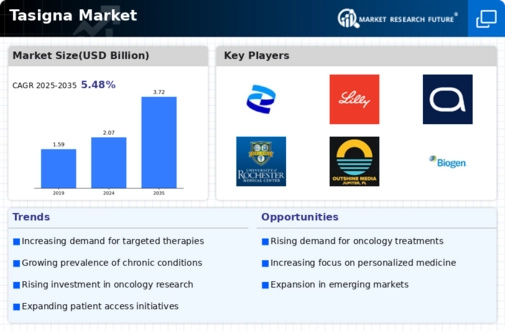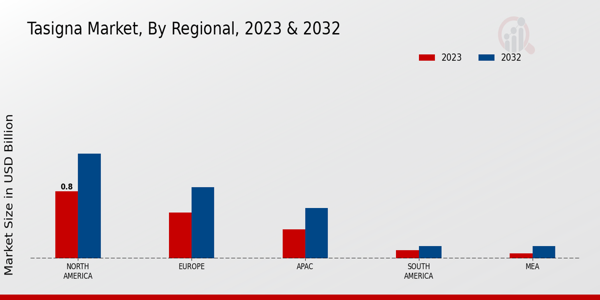Market Growth Projections
The Global Tasigna Market Industry is projected to experience substantial growth over the next decade. With an estimated market value of 2.07 USD Billion in 2024, the industry is expected to expand significantly, potentially reaching 3.72 USD Billion by 2035. This growth trajectory suggests a compound annual growth rate (CAGR) of 5.46% from 2025 to 2035. Such projections indicate a robust demand for Tasigna, driven by factors such as increasing incidence of CML, advancements in targeted therapies, and growing investment in cancer research. These dynamics collectively contribute to a favorable market outlook.
Advancements in Targeted Therapies
Innovations in targeted therapies significantly influence the Global Tasigna Market Industry. Tasigna, a tyrosine kinase inhibitor, exemplifies the shift towards personalized medicine, which is becoming increasingly prevalent in oncology. The ability to tailor treatments based on genetic profiles enhances efficacy and minimizes side effects, appealing to both healthcare providers and patients. As the medical community embraces these advancements, the market is likely to see substantial growth. The anticipated increase in market value from 2.07 USD Billion in 2024 to 3.72 USD Billion by 2035 underscores the potential impact of these innovations on patient outcomes and overall market dynamics.
Growing Investment in Cancer Research
The Global Tasigna Market Industry benefits from heightened investment in cancer research and development. Governments and private entities are allocating substantial resources to explore new therapeutic options for CML and other malignancies. This influx of funding fosters innovation and accelerates the development of drugs like Tasigna. As research initiatives expand, the market is poised for growth, with projections indicating a rise from 2.07 USD Billion in 2024 to 3.72 USD Billion by 2035. Such investments not only enhance treatment options but also improve patient access to cutting-edge therapies, thereby potentially increasing the market's reach and impact.
Regulatory Approvals and Market Access
Regulatory approvals play a crucial role in shaping the Global Tasigna Market Industry. The timely approval of Tasigna by health authorities facilitates its availability to patients, thereby driving market growth. As regulatory bodies continue to streamline processes for oncology drugs, the accessibility of Tasigna improves, leading to increased adoption among healthcare providers. This trend is likely to contribute to the market's expansion, with projections indicating a growth from 2.07 USD Billion in 2024 to 3.72 USD Billion by 2035. Enhanced market access not only benefits patients but also encourages pharmaceutical companies to invest in further research and development.
Increased Patient Awareness and Education
Patient awareness and education are pivotal in the Global Tasigna Market Industry. As more individuals become informed about CML and its treatment options, the demand for effective therapies like Tasigna rises. Educational initiatives by healthcare organizations and advocacy groups play a significant role in disseminating information about the disease and available treatments. This heightened awareness is likely to drive market growth, with projections suggesting an increase from 2.07 USD Billion in 2024 to 3.72 USD Billion by 2035. As patients become more proactive in their healthcare decisions, the adoption of Tasigna may see a corresponding rise, further influencing market dynamics.
Rising Incidence of Chronic Myeloid Leukemia
The Global Tasigna Market Industry is experiencing growth due to the increasing prevalence of chronic myeloid leukemia (CML). As more individuals are diagnosed with CML, the demand for effective treatments like Tasigna rises. In 2024, the market is projected to reach 2.07 USD Billion, reflecting the urgent need for innovative therapies. The growing awareness of CML and advancements in diagnostic techniques contribute to early detection, further driving the market. This trend is expected to continue, with the market potentially expanding to 3.72 USD Billion by 2035, indicating a robust CAGR of 5.46% from 2025 to 2035.













